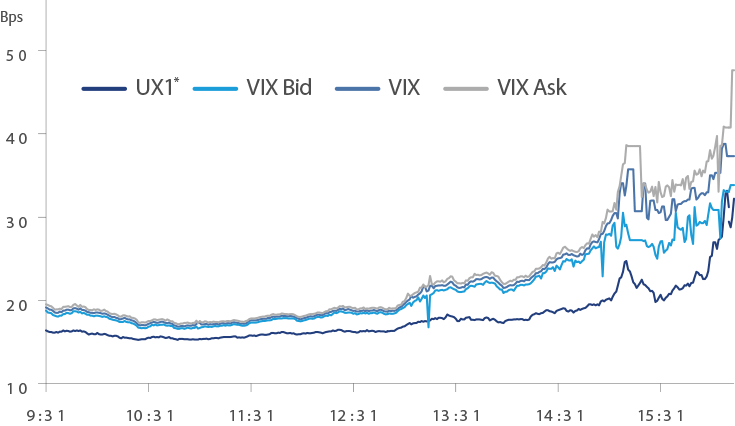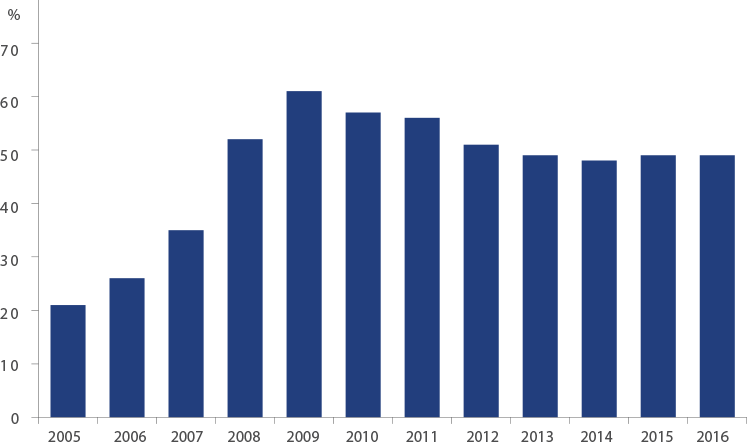Liquidity Shock: The Hidden Risk in Modern Markets

Summary
The risk of volatility spikes and liquidity shortages is rising, and it could get worse with new “quantitative tightening” policies from central banks. Politicians and regulators may eventually step in, but investors should take steps now to help guard against the possible loss of liquidity.
Key takeaways
|
Today’s markets contain hidden risks that increase vulnerability to volatility spikes and liquidity shortages.
The main sources of these risks are financial product innovations, automated and algorithmic trading practices, and regulatory adjustments put in place after the 2008 financial crisis as a means of strengthening markets. Also contributing to more “accident-prone” markets are diminished bank-bond inventories, the growth of high-frequency trading, and the proliferation of ETFs and rules-based trading strategies. In coming years, the gradual removal of monetary accommodation by central banks – which shrinks funding liquidity – threatens to exacerbate these risks.
Liquidity Shortages Exacerbated February’s VIX Spikes
VIX bid-ask spreads on 5 Feb 2018

*The front month VIX future index
Source: Barclays Research, Bloomberg
The brief but dramatic episode of financial market turbulence at the start of 2018 serves as a reminder to investors to account for potential liquidity shortages in their risk-management practices. Protecting a portfolio against liquidity shocks requires a system to identify predictive signs of disruption, as well as having palliative action plans in place designed to meet these jolts. Meanwhile, Congress and regulators would be wise to support micro- and macro-prudential measures that can minimize risks related to the availability of liquidity, helping build investor confidence and, potentially, soften the impact of liquidity shocks.
Learning from the past: Lessons from the 2008 crisis
To be sure, financial markets became more liquid as the financial system regained strength following the 2008 crisis. Monetary authorities were forced to step in to assure that illiquidity in specific funding markets did not lead to sequential disruptions that would make the entire financial system inoperable. These actions proved highly effective.
Since the crisis, markets have also been made more mechanically efficient as a result of technological advances and product innovations. Worldwide, trades today are executed nearly instantaneously and at transaction costs that are only a fraction of what they were a few years ago. In particular, fixed-income markets have been transformed as barriers to entry have fallen and new liquidity providers have stepped forward. In turn, new electronic infrastructure also allows a more diverse set of investors to participate, increasing competition and improving market liquidity. Bid-ask spreads are now meaningfully tighter, complex documentation has been eliminated and risk has been reduced.
However, redesign of the financial landscape may have elevated liquidity risk, too. For example, reversal of the actions by central banks to assure market liquidity will entail many unknowns that could cause liquidity shortages and devolve into security prices cascading downward. As tighter monetary policy causes interest rates to rise, public and private sector debt servicing costs will climb and some marginal borrowers might be crowded out.
Furthermore, safeguards put in place by regulators to make the banking and financial systems more resilient, such as capital and leverage requirements, may make banks less willing to accept non-operating, short-term deposits, reluctant to underwrite stock issuance through rights offerings, and unwilling to buy bonds if a financial shock arises.
Ironically, algorithmic and automated trading platforms present challenges to market liquidity. Given the hyper-speed of automated transactions, apparently simple and innocent actions, can quickly initiate – without human intervention – a chain of compounding problems. These challenges can become even more daunting when transactions respond to rule-based approaches tied to low-volatility, momentum and dynamic-hedging strategies, particularly when investor confidence and market performance turn negative.
Liquidity from High-Frequency Traders Could Prove Ephemeral in Crisis
High-frequency trading as a percentage of overall US equity trading

Source: TABB Group, Allianz Global Investors as at 31 December 2016.
Even ETFs, whose enormous popularity among retail investors reflects little concern about potential illiquidity, could face a disorderly loss of value under crisis conditions. In the end, ETFs are only as liquid as their least-liquid holding. If bid-ask spreads widen as financial conditions deteriorate, fewer traders will enter the ETF market, leading to decreased liquidity and wider price swings. Redemption of fund units then leads to across-the-board selling of the underlying securities and contagion across asset classes which might send shock waves of distress to other markets.
In the event that a financial correction becomes intense, investors must be on the watch for rapidly falling security prices that could force asset holders to shrink their portfolios and hoard liquidity.
3 ways to guard against the loss of liquidity
- Maintain a broadly diversified portfolio to buffer against illiquidity in any individual market
- Use derivatives in portfolio construction, which tend to be more liquid than individual securities and investment funds
- Lengthen investment horizons to build in sufficient time to recover from losses incurred in disrupted markets, and avoid crowded trades to minimize the risk of entrapment if other market participants attempt to exit simultaneously.
Investing involves risk. The value of an investment and the income from it will fluctuate and investors may not get back the principal invested. Past performance is not indicative of future performance. This is a marketing communication. It is for informational purposes only. This document does not constitute investment advice or a recommendation to buy, sell or hold any security and shall not be deemed an offer to sell or a solicitation of an offer to buy any security. The views and opinions expressed herein, which are subject to change without notice, are those of the issuer or its affiliated companies at the time of publication. Certain data used are derived from various sources believed to be reliable, but the accuracy or completeness of the data is not guaranteed and no liability is assumed for any direct or consequential losses arising from their use. The duplication, publication, extraction or transmission of the contents, irrespective of the form, is not permitted. This material has not been reviewed by any regulatory authorities. In mainland China, it is used only as supporting material to the offshore investment products offered by commercial banks under the Qualified Domestic Institutional Investors scheme pursuant to applicable rules and regulations. This document is being distributed by the following Allianz Global Investors companies: Allianz Global Investors U.S. LLC, an investment adviser registered with the U.S. Securities and Exchange Commission; Allianz Global Investors GmbH, an investment company in Germany, authorized by the German Bundesanstalt für Finanzdienstleistungsaufsicht (BaFin); Allianz Global Investors Asia Pacific Ltd., licensed by the Hong Kong Securities and Futures Commission; Allianz Global Investors Singapore Ltd., regulated by the Monetary Authority of Singapore [Company Registration No. 199907169Z]; Allianz Global Investors Japan Co., Ltd., registered in Japan as a Financial Instruments Business Operator [Registered No. The Director of Kanto Local Finance Bureau (Financial Instruments Business Operator), No. 424, Member of Japan Investment Advisers Association and Investment Trust Association, Japan];and Allianz Global Investors Taiwan Ltd., licensed by Financial Supervisory Commission in Taiwan.
460368
10 Key Facts about China A-Shares

Summary
In May 2018, a number of China’s A-shares will become part of MSCI’s flagship emerging-market index for the first time, and we believe investor interest is likely to grow. But in many ways, this market is as misunderstood as it is underrepresented in portfolios, so here are 10 things investors should know.
Key takeaways
|





